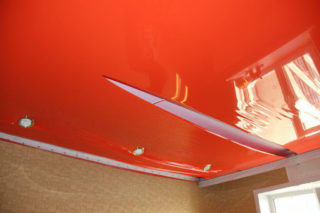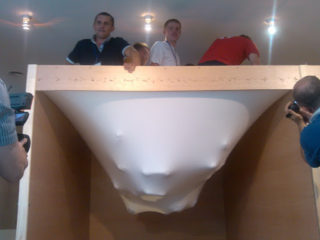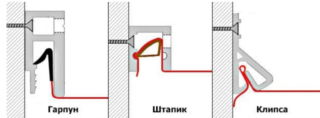Stretch ceiling is often found in residential and office premises. This option is extremely decorative, diverse, allows you to hide any communications, is not afraid of water and sun. However, he is not immune from damage: a scratch or accidental rupture quickly turns into large damage, after which the canvas can only be dismantled.
Reasons for dismantling a stretch ceiling

A suspended ceiling is a material that is fixed to the walls under some pressure - in a stretched state. In this case, the canvas forms a perfectly flat surface. However, this tension makes him vulnerable. The slightest damage immediately turns into a huge hole.
In some cases, you can stop the divergence of the material, put a patch. However, in some cases, dismantling the tensioning structure is the only possible solution.
- Break or damage away from the wall. With a small distance, the material can be dragged so that the spread canvas is outside the baguette. However, it is impossible to get rid of the gap in the center in this way.
- When installing lamps in the canvas, it is necessary to make a hole and fix it with a special ring or plate. If the hole is too large and the divergence cannot be stopped, the film will have to be removed.
- The ceiling is not afraid of leakage: the film can withstand up to several tons of water. But in order to remove the accumulated water, it is often necessary to cut the film or partially remove it.
- It is necessary to change the design of the room.
Another case of discrepancy is the separation of the baguette and damage to the film. Repairs may not be possible depending on how the latter is secured. This case applies to insurance, dismantling and installation of a new ceiling is carried out at the expense of the installers.
Varieties of stretch ceiling design
A special profile is fixed on the walls along the perimeter of the room. Then the canvas is fixed in the baguette and stretched. The characteristics of this design depend on the materials used.
the cloth

For the ceiling, a polyester fabric of knitted weaving is used: this allows you to stretch it and achieve a flat surface. The fabric is impregnated with various compounds that provide high wear resistance, dirt-repellent effect, and insensitivity to cold. The fabric ceiling is not electrified and does not attract dust, which makes it less likely to vacuum.
The dimensions of the fabric are not limited. However, the ability to stretch the fabric is a limitation, so that the fabric ceiling is installed only in small rooms. The material is not afraid of the cold; such rooms can be left unheated in winter. Decorative possibilities are provided by a wide range of colors, different textures.
The disadvantage of the product is its resistance to water. The fabric still absorbs water, does not withstand leaks, salts dissolved in water leave traces on it. The fabric ceiling can only be flat.
Film

Its coefficient of elasticity of a polyvinyl chloride film is much higher, so the film ceiling can have enormous dimensions. The film is not afraid of water, steam too, does not absorb dirt, soot, grease, odors.
The film web is collected from strips of material. However, the seams on it are hardly noticeable, so it is difficult to consider it a disadvantage. This allows you to combine films with different colors and images. The material reproduces any texture: velvet, glossy, mirror, matte. The surface can be flat, form waves, domes, arches.
The disadvantage of the film is its low mechanical strength. Even with small breaks, the canvas has to be dismantled, since it cannot be repaired.
Methods of fastening the structure
The ability to make repairs depends on the method of attachment. There are 3 main mechanisms.
Harpoon

Along the perimeter of the canvas, a special type of edge is welded, resembling a hook - a harpoon. When installing, the harpoon is tucked into a baguette. Such a canvas is cut out exactly to the size of the room, since there is no need to stretch it.
The harpoon method is very convenient for a complex room configuration, as it allows you to take into account all the features in advance when cutting out. Another plus: simplicity and the possibility of partial and complete dismantling without destroying the product. The harpoon is simply separated from the baguette. However, the same feature makes it difficult to repair with small cuts: you cannot overtighten the canvas.
Clip
The clip or cam method is suitable for fastening only fabric. The material is tucked into a baguette and clamped with a profile like a clothespin. A plinth must be installed around the perimeter of the room, since there is a technological gap between the ceiling and the wall.
Dismantling of such a structure is possible, but leads to damage to the profile.
Wedge
The wedge or glazing method is classified as budgetary. Fixation of the film web is carried out due to the design of the profile itself. When installing, the material is stretched, removing the excess beyond the profile, and then they are cut off. This method does not require careful preliminary measurements or high cutting accuracy. During installation, a technological gap also remains.
Dismantling is difficult. If the film is damaged, the entire canvas will have to be changed.
Preparatory work

To remove the stretch ceiling with your own hands, repair and put back, you need the following tools:
- spatula - special, with rounded corners; you can take an ordinary building one with a width of 9-10 cm and first grind edges and corners on it;
- screwdriver with a bent end;
- mounting pins - used for temporary fixation;
- long-jawed pliers.
When dismantling the PVC canvas, you will need a heat gun or a construction hair dryer.
The preparatory work is extremely simple:
- all objects that are afraid of heating are taken out of the room, for example, an antique table, living plants;
- locked in another room for pets;
- remove all ceiling lights;
- cover furniture, aquariums and other items that cannot be taken out with canvas or bedspreads.
If dismantling is carried out due to a leak and the water is still held by the canvas, you need to prepare buckets to take out the water. At the same time, carpets are removed from the floor, upholstered furniture is protected with foil.
Removing a stretch ceiling with your own hands

Dismantling a stretch film or fabric ceiling depends on the mounting method. If a harpoon mount is used, the procedure is as follows:
- Disassemble the decorative plinth.
- Warm up the film with a gun or hairdryer. The material stretches under the influence of temperature, then the mount is easier to remove. Warm up the ceiling from the center to the corners.
- Squeeze the harpoon with a screwdriver, insert a spatula into the slot and pry off the edge. Moving the spatula in the baguette, gradually squeeze the profile attachment. The same is done on the opposite wall.
- The spatula is pulled downward, releasing the blade. They move along the profile along the perimeter of the room, pulling the film.
If you want to reuse the canvas, you need to act very carefully.
With a glazing bead, the dismantling algorithm is as follows:
- The film web is heated. The fabric ceiling does not need to be heated.
- The profile is gently unbent with long-jawed pliers.
- They put a spatula behind the glazing bead and pull it down. The fastener comes out of the groove and the web is released.
It is possible to dismantle a ceiling with a glazing bead if the installers left a sufficient supply of material during installation. Otherwise, it will be impossible to re-stretch the film.
Removing the fabric ceiling is even easier:
- Remove the decorative skirting board.
- At the junction of the ceiling and walls, press on the canvas, pulling it, and at the same time unclench the clip with pliers. When the tension on the fabric looses, it can be pulled out of the fastener.
Re-assembly is only possible if the fabric is not cut too short.








